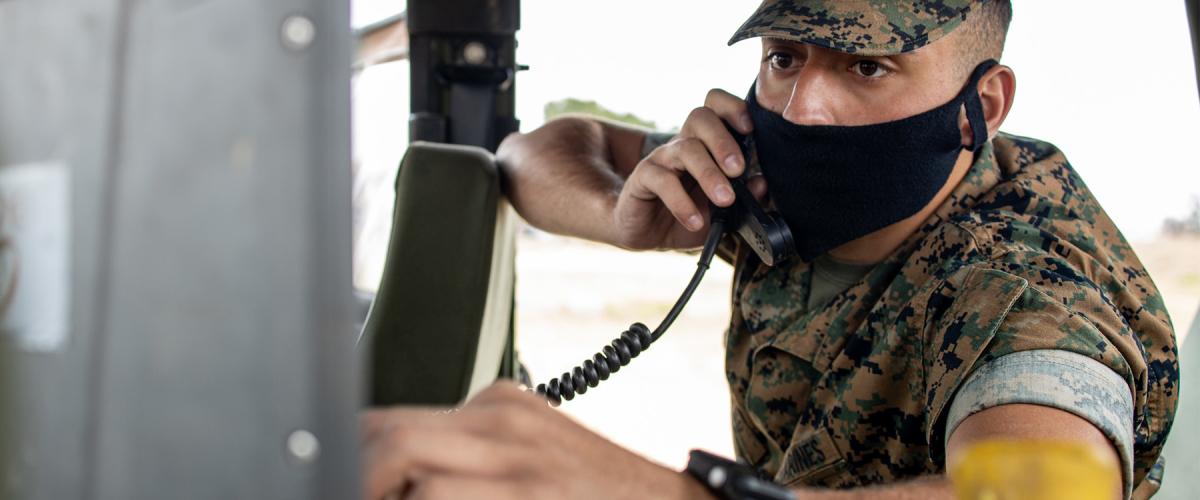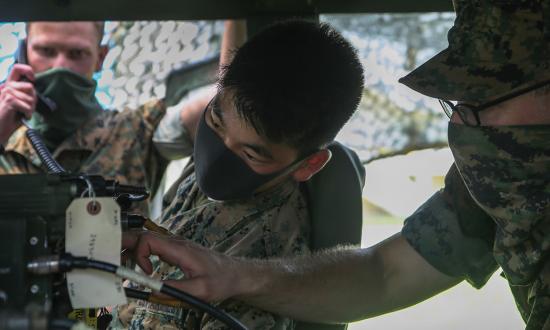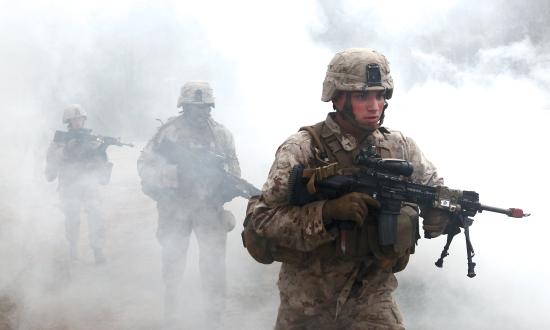For more than 35 years a Russian radio tower has broadcast a strange and continuous drone that is periodically interrupted by a second tone. The broadcast can be picked up by short-wave radio operators tuned to the frequency 4625 kHz, and it has been given the moniker “The Buzzer” or alternatively UVB-76. There are thousands of enthusiasts who follow this enigmatic signal to listen for any changes—despite not knowing its purpose—and they have periodically heard the buzzing tone interrupted by a string of numbers or the recitation of words in Russian.
“John has a long mustache.” Devoted fans with intricate knowledge of the World War II cinematic saga The Longest Day may remember this as a key signal broadcast to the French Resistance to alert them to prepare for the coming D-Day invasion. Attentive viewers of a later drama may remember the phrases: “The chair is against the wall. John has a long mustache,” as part of a message broadcast to the occupied areas of the United States in 1984’s dystopian classic Red Dawn (the director included the mustache phrase as an homage to the earlier film). These movie plot points were drawn from real history. During World War II, the BBC included covert messages to the resistance in its radio programming.
Perhaps as far back as World War I, governments began broadcasting coded messages to spies operating in foreign territory using an unbreakable method—reciting numbers, letters, or phrases over the airwaves that had no meaning to anyone who did not have the cipher, generally a one-time pad that would only be used a single time by both recipient and sender. These became known as numbers stations, though their existence or function has never been acknowledged by any government. This method’s heyday was the Cold War, but as UVB-76 demonstrates, they continue to be used to this day. (Some claim this Russian system is for internal military communications rather than espionage abroad, while others believe it is part of the Russian “dead hand” system established to ensure that a retaliatory nuclear salvo is launched in the event that Kremlin leadership is decapitated by a U.S. first strike.) In the past decade, North Korea re-established a numbers station after nearly two-decades of silence. These seemingly throwback methods could provide a key tool in the high-tech wars of the future.
Why Now?
The U.S. Marine Corps should consider establishing short-wave radio numbers stations for use in any great power conflict, as they could provide unique capabilities in a war against a peer or near-peer competitor. Numbers stations could be enablers for missions that do not require immediate action nor two-way communications. The stations could help coordinate logistics with dispersed low-signature logistics platforms—such as amphibious aircraft waiting for their cue to retrieve a deployed expeditionary advanced base operations (EABO) element, or for surrogate/allied forces to execute a planned resupply mission. Numbers stations may even be ideal for conveying instructions to forces engaged in EABO, which are in EMCON status (i.e., not emanating communications).
Numbers stations have potential for several reasons. First, they could provide secure one-way communications with global reach. Second, short-wave transmitters are difficult to locate, hard to jam, cheap, and do not rely on satellite communications. Third, the unit or individuals receiving the transmission can do so without creating an observable signature. This is key given that in a high-intensity conflict between great powers, most envision a threat environment in which the ubiquity of enemy sensors will result in an environment in which anything that can be sensed can potentially be struck. The ongoing war in Ukraine validates this concern. Planners studying the conflict for insights are increasingly studying ways to avoid emitting radio signals. As a result of the Russian military’s ability to geolocate radio transmissions, Ukrainian defenders are using low-tech solutions (such as runners) to avoid discovery and a follow-on attack.
Properties of Short-Wave Radio
The properties of short-wave radio make it a tool that could be used by Marine forces across a spectrum of operations, whether they are supporting NATO allies in the Baltics, contesting the first or second island chains, assisting stay-behind forces battling Russians, or facilitating a Taiwanese guerrilla movement. Numbers stations operate via short-wave, high-frequency-band radio transmissions. Short-wave exhibits unusual properties that make it a unique tool. Short-wave radio operates by bouncing radio-waves off of the ionosphere, which can allow stations to reach locations thousands of miles away. This property made them useful for numbers stations. Transmission across great distances, cheaply, and off-line is why short-wave radios are increasingly being used in the war in Ukraine. The bouncing or skipping of the transmission is why locating the point of origin of the message is extremely difficult.
An Asymmetric Advantage: Countering Adversaries’ Counterspace Efforts
In its Fifth Space Threat Assessment (2022), the Center for Strategic International Studies stated that potential adversaries recognize how much U.S. military relies on satellites, and for this reason many countries—such as China, Russia, North Korea, and Iran—have sought counterspace weapons to gain an asymmetric advantage in potential conflicts against the United States. That Russia is aggressively pursuing enhanced capabilities is well-known. Similarly, in the event of a conflict, Chinese doctrine is to attack U.S. satellites to degrade or block U.S. battlefield communications. To this end, China’s military is pursuing a suite of counterspace weapons. The recent success of the Starlink satellite system in Ukraine has led to Chinese research on ways to use “soft and hard-kill methods” to counter this constellation.
Numbers stations do not rely on satellites, nor are they transmitted over the internet and susceptible to cyberattack. Their low-tech analog nature makes them immune to many of the high-tech counters potential adversaries are developing to disrupt U.S. military communication. In the event a numbers station transmitter is destroyed, another can readily take its place. Stations could be established in the United States, but also in allied countries closer to potential theaters of conflict. These are not boutique, exquisite systems, but rugged, functional, and relatively inexpensive ones that allow for redundancy and an uninterrupted communications method.
During the Cold War, the Soviet Bloc expended vast resources to jam broadcasts from Voice of America, BBC, and other stations attempting to provide uncensored news to those living behind the Iron Curtain. Despite the thousands of jamming transmitters, and tens of millions of dollars, short-wave radio transmissions are hard to jam, and Western programming regularly got through. By its very nature, short-wave radio is difficult to block, particularly at dawn and dusk for between one to five hours.
In contrast to the intricacies involved in locating and attempting to jam messages sent by a numbers station, identifying a jamming station (which is radiating on the electromagnetic spectrum) is generally straight forward. Moreover, enemy jammers could be attacked a variety of ways. As an example, it would not be difficult for Marine or Navy aircraft to attack enemy jamming platforms through the use of antiradiation missiles such as the Navy’s new AGM-88G Advanced Anti-Radiation Guided Missile Extended Range (AARGM-ER) which, though designed primarily as an antiair defense weapon, can target radio or jamming platforms. The AARGM-ER has been designed to have extended range that is “more survivable and effective” and to be used by F-35 fighter aircraft.
Secure Method
Coded messages sent by numbers stations most often are sent after encryption with a one-time pad or using a specific cipher known only to the receiving unit, which creates a secure communication that cannot be cracked even by the most advanced cryptographic resources. Units awaiting messages do not emanate in the electromagnetic spectrum, but passively monitor a short-wave radio frequency. Receiving units would know when to tune in for a message and hearing a preparatory tone or phrase to be alerted that a message is intended for them and thus to be ready to receive one. The broadcast also could issue new times to listen for instructions or provide new frequencies for future messages.
Numbers stations are more appropriate for passing instructions that are to be executed at a routine-level of precedence (typically 12–24 hours, though if instructed to react on receipt, it is likely the receiving unit could execute immediately if they had been prepared and awaiting a “go” command), than for immediate messaging such as tactical instructions during a battle. Thus, numbers stations could best be means of conveying instructions to deliver supplies or schedule a delivery or exfiltration mission. (The lack of a response by a receiving unit is an obvious downside, but no different from a situation in which a unit is operating in strict emissions control, which may be common in conflict against a peer competitor.)
Enabling and Coordinating Logistics
Numbers stations would be a great means to coordinate logistics, particularly some of those that have been proposed as methods for a more clandestine signature to support “untethered logistics” in a contested environment. Marine Corps Commandant General David H. Berger predicted the threat may be so great in a future war in the Pacific that Marines might only be able to count on the most essential supplies getting through. “It's just fuel and bullets, that's what I'm going to resupply. The rest you’re going to have to forage.” Given the severe challenges Marines are expected to face to remain provisioned, it is incumbent on the Marine Corps to find ways to minimize signatures to allow units to be resupplied to the maximum extent possible.
The Defense Advanced Projects Research Agency’s (DARPA’s) proposed Liberty Lifter heartens those who have suggested seaplanes may provide an ideal method for supporting widely distributed Marine Corps units in the Pacific. Dispersed seaplanes could rely on number stations to tell them when to rendezvous with deployed units for resupply or exfil, or alternatively when to take on fuel, supplies, weapons, etc., from tenders/support ships, submarines, or unmanned underwater vehicles. This communication method also could serve covert logistics networks—such as the “sleeper-cell logistics” proposed in an award-winning essay by Marine Corps Captain Michael Sweeny.
The Commandant said the Marine Corps needs to develop means to “move supplies, reposition forces, keep them sustained [with] affordable ships that are smaller, lower signature [in a contested environment].” To that end, numbers station communications would work well with a low-signature “modern Shetland bus” of civilian maritime vessels, which would have excellent cover for being equipped with, and monitoring, short-wave radios. Fishing fleets and other ocean-borne craft are outfitted with maritime Single Sideband, i.e. short-wave (SSB) radios, in accordance with the Global Maritime Distress and Safety System established under the International Convention for the Safety of Life at Sea.
Additional Uses
In the future, numbers stations also could be used by stay-behind forces to conduct guerrilla warfare in occupied territories. Marines are already increasingly engaged in training with foreign militaries in potential flash-points from Taiwan to the Baltics to Scandinavia—a current point of friction with the recent application to NATO of Sweden and Finland. Like modern Jedburghs (the famed World War II three-man teams that parachuted in with radios to assist resistance fighters), establishing means to communicate with allied guerrilla elements may be a role for Marine Forces Special Operations Command (MARSOC), but potentially fleet Marines as well.
The Marine Corps is currently engaged in developing doctrine for stand-in forces (SIF). Their primary function is to execute reconnaissance and counter-reconnaissance missions. The Commandant envisions these forces will avoid enemy detection, “by maintaining a low signature, moving frequently and unpredictably, and using deception.” Though numbers stations cannot serve as the exclusive means for communicating with SIF units, including their use in the SIF tool-box would further General Berger’s goal to use deception and ensure a reduced signature.
Success in lethal and complex great power conflict will require multiple methods and systems. Adversaries have studied the U.S. military over the past two decades and drawn important conclusions. They recognize the U.S. use of satellites has been a key advantage in everything from communication to dropping precision-guided bombs, and thus they intend to take that capability away. Moreover, the degree of sophistication in identifying units by electronic signature demonstrated in the current war in Ukraine has revived interest in finding nonstandard or alternative means of communication. Numbers stations communicating by short-wave would provide a novel means for Marines to reduce their signature—particularly for coordinating nonstandard logistics—in a contested environment. In the future, Marines, along with descendants of former World War II partisans fighting in the Pacific or behind Russian lines in the Baltics, may be tuning their radios at a set time to listen for updates on the state of John’s mustache.






